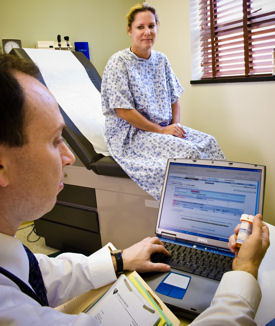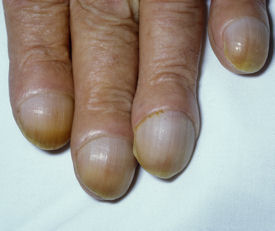E-prescribing order hits unprepared internists
Congressional mandates to tip internists to use e-prescribing could backfire, say experts who have tried—and sometimes failed—to incorporate the technology into their offices.
At first glance, e-prescribing appears to solve many of the problems associated with handwritten prescriptions, such as reducing medication errors, eliminating time spent writing scripts and transferring them to the medical records. But most physicians still use paper systems and many say they can't make a convincing business case for converting.
Now, Congress is forcing the issue by mandating a phase-in of e-prescribing as part of Medicare legislation passed in July. Starting Jan. 1, 2009, physicians who e-prescribe will receive a 2% bonus on their Medicare claim payments in 2009 and 2010. The incentive falls to 1% in 2011 and 2012 and 0.5% in 2013. Physicians who don't e-prescribe will be penalized 1% in 2012, 1.5% in 2013, and 2% thereafter.
Will the many doctors who haven't switched be able to get e-prescribing up and running before the penalties kick in?
“What we're hearing from our members who are not yet using an EHR (electronic health record) is not encouraging,” said Thomson Kuhn, senior systems architect with ACP's Regulatory and Insurer Affairs department. “They're hard-nosed businesspeople who have looked at this and said there is just not enough benefit. It's certainly possible that the deadline is going to come and go and a lot of [ACP] members are not going to be e-prescribing.”
The decision to mandate e-prescribing is backed by Institute of Medicine data that say 1.5 million Americans are injured by preventable drug errors, with other reports arriving at far higher estimates. The nonprofit Institute for Safe Medication Practices estimated that pharmacists make 150 million phone calls a year to clarify written prescriptions.
However, using mandates to convince physicians to switch could backfire, said Patricia Hale, FACP, who oversees EHR implementation for the state of New York.
“People will just not be complying and you'll be driving out more physicians,” she said. “If the goal is to drive out primary care physicians in rural and inner-city areas, that's what you'll get.”
Few ready for incentives
The Centers for Medicare and Medicaid Services (CMS) has entered its rulemaking process, which will determine how to carry out the Congressional mandate, followed by a roll-out to physicians and pharmacies so they can report e-prescribing on Jan. 1, 2009. But research suggests that only a small fraction of physicians are meeting all of the likely requirements for e-prescribing.
A June 2008 report by the eHealth Initiative, a collaborative of health care organizations and private companies including ACP, concluded that only 2% of prescriptions are filled electronically and about 6% of physicians e-prescribe. Furthermore, only 4% of physicians have a fully functioning EHR with e-prescribing capability, and another 13% have a basic system that may or may not allow e-prescribing, according to a study published in the June 2008 New England Journal of Medicine.

William E. Fox, FACP, an internist in Charlottesville, Va., is one of the few whose prescriptions reach pharmacists meeting the proper standards.
“I'm pleased that Congress is recognizing that e-prescribing costs money to me and will provide some financial support in the form of that incentive,” said Dr. Fox. “But penalizing physicians for not adopting a technology whose benefits have not been proven may not be appropriate.”
For those who comply with the new mandate, the 2% bonus could total between $3,000 and $4,000 for an average practice with an average Medicare billing load, estimated ACP's Neil Kirschner, senior associate, regulatory and insurer affairs. And once Medicare begins providing incentives, private payers are likely to follow.
Kerry N. Weems, CMS acting administrator, said in July that e-prescribing bonuses will be tracked through the same mechanism as the Physician Quality Reporting Initiative (PQRI), which pays another bonus to doctors who submit codes that measure quality of care for conditions such as diabetes, preventive care or kidney or renal disease. But CMS must create the mechanism during its rulemaking process.
ACP will work with CMS through the federally mandated rulemaking process to advocate for internist-friendly implementation of this new e-prescribing legislation, Mr. Kuhn said. Many questions remain unanswered. For example, what happens when pharmacies don't accept e-prescriptions? While major pharmacies are online, about 73% of independent pharmacies are not connected, reported the eHealth Initiative. What if a patient asks for a paper prescription because they haven't chosen a pharmacy, have chosen a different pharmacy or want to price-shop? Will the doctor be penalized for complying?
Also, mail-order pharmacies haven't widely adopted e-prescriptions. And controlled substances, which make up 20% of all prescriptions, must be written out until the Drug Enforcement Administration changes its rules.
CMS asked ACP to co-sponsor a two-day workshop in Boston Oct. 6-7 to help physician practices adopt e-prescribing and meet provisions of the new legislation. ACP will provide updates about the conference by e-mail in ACP InternistWeekly.
Standalone systems have flaws
E-prescribing systems can stand alone, but experts recommend implementing them as part of a full EHR system. Dr. Hale, deputy director of the New York State Office of Health Information Technology Transformation, is on her fourth e-prescribing system in eight years. Three previous ones fell through when the companies went out of business. She now uses a free system offered by a large private company, but it doesn't tie into her EHR.
A former full-time internist who keeps part-time practices in both an urgent care setting and an osteoporosis clinic, Dr. Hale noted that even free systems have drawbacks, such as training time and costs. And there are other costs, such as upgrades to better systems or subscription fees, according to the eHealth Initiative.
ACP is among those who recommend physicians bypass standalone e-prescribing systems and install a fully functioning EHR. Standalone systems don't necessarily offer the functions that really make a difference, said Mr. Kuhn, such as medication reconciliation, drug interaction checking, and right-drug right-dose verification.
“Are we trying to improve the quality of care or are we just trying to do electronic handoff of information?” added Will Underwood, ACP's senior associate with the Center for Practice Improvement and Innovation.
The College has launched an electronic roadmap and its EHR Partners Program, a list of vendors who follow a particular standard, the Certification Commission for Healthcare Information Technology, to help physicians sort through the many products on the market.
But fully functioning EHRs can cost 10 times as much as standalone systems, an estimated $30,000 to $50,000 per physician, Mr. Kuhn said. “We realize that it's cheaper and it's easier for those members who don't have an EHR,” Mr. Kuhn said. “But we feel that the only way that the patients actually benefit as well as the doctors is when there's a full EHR involved.”
Hook up with hospitals
As a saving grace, hospitals (and other health organizations) are offering deeply discounted EHRs to doctors in their communities through a specific exemption to the kickback laws that would normally outlaw such an offer, since hospitals might otherwise benefit from directing patient labs, for example, to their own facility. Hospitals are big enough to recoup the benefits of creating their own fully integrated system, and now they're extending those systems to community physicians, Mr. Kuhn said.
Hospitals can hook up new doctors every few weeks. Franciscan Missionaries of Our Lady Health System in Baton Rouge, La., which is undergoing its roll-out, detailed their progress in the Winter 2008 Journal of Health Information Management. The Cleveland Clinic offers MyPractice Community, a Web-based system.
And doctors worried about paying for EHRs are considering such offers. Dr. Hale, for example, is waiting for her hospital to offer its system to her, which would allow her to integrate her separate EHR and e-prescribing systems.
“For a good chunk of our members this may be the route by which they get an EHR,” Mr. Kuhn added. “What we've heard from early adopters of [hospital-based EHRs] is that it's turning out to be pretty effective.”




